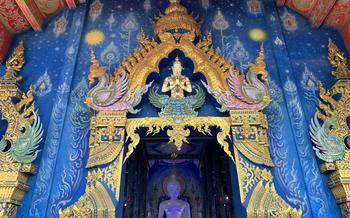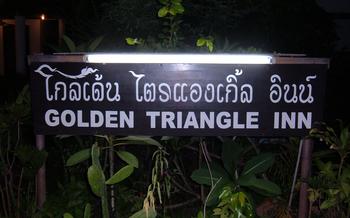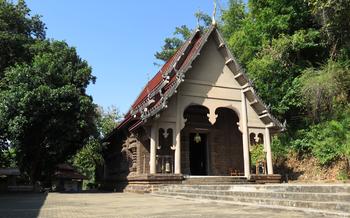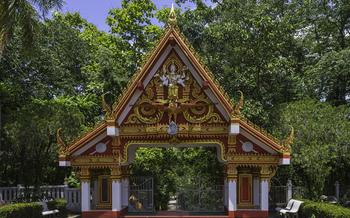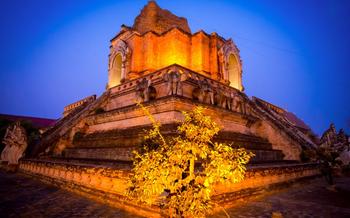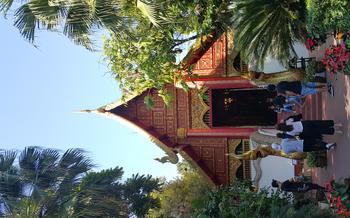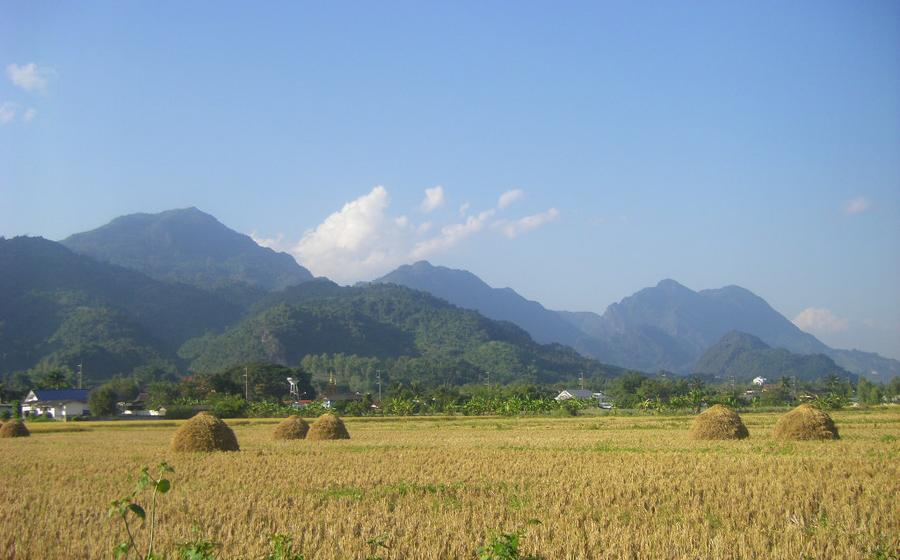
Doi Nang Non
- Reaching the Summit
- Exploring the Temple Grounds
- The Grand Staircase
- The Golden Chedi
- Views from the Top
- Photography Opportunities
- Cultural Significance
- Local Markets and Souvenirs
- Nearby Attractions and Activities
- Respectful Behavior and Etiquette
- Insider Tip: Unforgettable Experiences at Doi Nang Non
Reaching the Summit
Reaching the summit of Doi Nang Non is an adventurous journey that offers a variety of transportation options. For those seeking a comfortable and private experience, hiring a car with a driver is an excellent choice. The scenic route winds through picturesque landscapes, providing breathtaking views along the way. Alternatively, songthaews, shared taxis, are a more affordable option, offering a local experience as you share the ride with fellow travelers.
For the adventurous, renting a motorbike is an exhilarating way to explore the winding roads and immerse yourself in the natural beauty of the surroundings. The cost of transportation varies depending on the chosen mode, but the journey typically takes around 1-5 hours from Chiang Rai city.
En route to the summit, you'll encounter several hiking trails that offer a more immersive and active experience. These trails meander through lush forests, providing opportunities to connect with nature and enjoy the tranquility of the surroundings. The trails vary in difficulty, catering to hikers of all levels, and offer a unique perspective of the mountain's diverse flora and fauna.
Exploring the Temple Grounds
As you step through the gateway of Doi Nang Non, a realm of tranquility and devotion unfolds before you. The main temple building, with its elegant spires and intricate carvings, stands majestically at the heart of the complex. Inside, the air is heavy with incense and the soft chanting of monks. The walls are adorned with vibrant murals depicting scenes from the life of Buddha and the history of Lanna.
Scattered around the main temple are smaller shrines and Buddha images, each with its unique story and significance. Visitors can pay their respects and make offerings, perpetuating a tradition that has been passed down for generations. The temple grounds are also home to meticulously manicured gardens, serene walkways, and shaded resting areas where pilgrims and visitors can find respite from the sun and soak in the peaceful ambiance.
Offerings and donations play a vital role in sustaining the temple and supporting the monks who reside here. Visitors are encouraged to make offerings of flowers, candles, or incense as a way of expressing their gratitude and seeking blessings. These offerings are not only a source of revenue but also a symbol of the deep connection between the temple and the community.
The Grand Staircase
The grand staircase of Doi Nang Non is an architectural marvel that leads visitors to the temple's summit. With its intricate details and symbolic representation, it's a challenge and reward in itself.
The staircase features hundreds of steps adorned with mythical creatures and floral motifs, each representing a stage in the journey towards enlightenment. Climbing the stairs is considered an act of devotion and a way to cleanse oneself from worldly desires.
While the climb can be challenging, the panoramic views from each level make it worthwhile. Take your time, pause to admire the intricate carvings, and soak in the beauty of the surrounding landscape.
To fully appreciate the experience, consider climbing the stairs barefoot, as is customary in many Thai temples. This will allow you to connect with the sacredness of the space and feel the cool stone beneath your feet.
Remember to bring water and wear comfortable shoes if you choose to hike up the mountain. You can also opt for a more leisurely ascent by taking a songthaew or motorbike to the top and then climbing the stairs down.
The Golden Chedi
The Golden Chedi of Doi Nang Non is a prominent landmark and symbol of the temple. Standing tall and majestic, the chedi is a testament to the architectural prowess and religious devotion of the Lanna Kingdom. Its history dates back centuries, with records indicating its construction during the reign of King Mangrai, the founder of Chiang Mai. The chedi underwent several renovations and embellishments over the years, culminating in its current stunning appearance.
The chedi's exterior is adorned with intricate golden designs and patterns, which shimmer and sparkle in the sunlight. The intricate artwork depicts scenes from Buddhist mythology and folklore, adding to the chedi's sacred and spiritual significance. At its base, four smaller chedis surround the main structure, symbolizing the four cardinal directions and providing a sense of balance and symmetry.
The Golden Chedi holds a special place in the hearts of the local community. It is believed to enshrine a sacred relic of the Buddha, which adds to its religious importance. Devotees often make offerings of flowers, incense, and candles at the base of the chedi, seeking blessings and paying homage to the Buddha's teachings.
Visitors are welcome to explore the chedi and admire its intricate details up close. However, it is important to maintain a respectful and mindful attitude when visiting such a sacred site. Removing shoes before entering the chedi's compound and observing silence are customary practices to show respect for the temple and its religious significance.
Views from the Top
The summit of Doi Nang Non offers unparalleled panoramic vistas that will leave you breathless. The entire Chiang Rai city stretches out before you, with the meandering Kok River snaking through the lush green landscape. Distant mountain ranges form a majestic backdrop, their peaks shrouded in mist and mystery. The best time to soak in these stunning views is during the early morning or late afternoon, when the golden light of the rising or setting sun casts a magical glow over the surroundings. Whether you're a seasoned traveler or a first-time visitor, the panoramic vistas from Doi Nang Non are sure to etch themselves into your memory forever.
Photography Opportunities
Doi Nang Non presents a treasure trove of photography opportunities for enthusiasts and casual photographers alike. The scenic landscapes and panoramic views from the temple grounds offer breathtaking backdrops for capturing the beauty of the surrounding nature. The unique temple architecture, with its intricate details and colorful decorations, provides a kaleidoscope of visual elements to explore. The colorful offerings and decorations that adorn the temple grounds add pops of color and cultural significance to your shots.
To make the most of your photography experience at Doi Nang Non, consider using a wide-angle lens to capture the expansive views. Experiment with different angles and perspectives to showcase the temple's grandeur and its harmonious relationship with the natural surroundings. Don't forget to play with the natural light; early mornings and late afternoons offer the most flattering lighting conditions.
When photographing the local people and monks, always ask for permission and be respectful of their privacy. Remember to maintain a respectful distance and avoid using flash photography, especially during ceremonies or religious rituals. Editing your photos can enhance the colors and bring out the details, but be mindful of preserving the authenticity and integrity of the images.
Cultural Significance
Doi Nang Non holds immense cultural significance as a symbol of faith and devotion. It is deeply rooted in Lanna culture and history, representing the strong Buddhist beliefs of the region. The temple serves as a place of pilgrimage for locals and visitors alike, who come to pay respects, make offerings, and seek spiritual merit. Its location atop the mountain enhances its sacredness, creating a serene and contemplative atmosphere. The temple's architecture, sculptures, and decorations are all expressions of Lanna craftsmanship and artistry, showcasing the region's unique cultural heritage. Visiting Doi Nang Non offers a glimpse into the vibrant spiritual traditions of Thailand, where Buddhism plays a central role in shaping the culture and way of life.
Local Markets and Souvenirs
As you descend from the sacred grounds of Doi Nang Non, don't miss the opportunity to explore the vibrant local markets nestled at the foot of the mountain. These bustling bazaars offer a kaleidoscope of handicrafts, souvenirs, and local products, providing a glimpse into the region's rich cultural heritage.
Stalls adorned with colorful textiles, intricate wood carvings, and shimmering silver jewelry line the market streets. Skilled artisans showcase their craftsmanship, creating unique pieces that capture the essence of Thailand's artistic traditions. From hand-painted ceramics to woven bamboo baskets, each item tells a story of creativity and cultural pride.
When shopping at these local markets, don't be afraid to engage in the art of bargaining. It's a friendly custom that allows you to connect with the vendors and secure the best prices. Remember to approach the process with a smile and a sense of respect, as it's not just about the price but also about the cultural exchange.
By supporting local artisans, you not only take home a piece of Thailand's cultural heritage but also contribute to the community's economic well-being. Every purchase you make helps preserve traditional skills and empowers local entrepreneurs.
So, as you wander through the vibrant markets of Doi Nang Non, embrace the opportunity to connect with the locals, discover unique treasures, and support the community that keeps this sacred mountain alive.
Nearby Attractions and Activities
Beyond the serene beauty of Doi Nang Non, Chiang Rai offers a plethora of compelling attractions and activities that await exploration. For those with a thirst for cultural immersion, venture into the heart of Chiang Rai city to discover an array of magnificent temples. Wat Phra Kaew, renowned for housing the revered Emerald Buddha, stands as a testament to the region's rich heritage. Wat Rong Khun, also known as the White Temple, captivates visitors with its unconventional and striking contemporary design, a stark contrast to the traditional Lanna architecture.
For those seeking adventure, the Golden Triangle, where Thailand, Myanmar, and Laos converge, beckons with its allure. Explore this fascinating region, once notorious for its opium trade, and delve into its history and diverse cultures. Embark on a thrilling jungle trek through lush rainforests, encountering exotic flora and fauna along the way. Encounter majestic elephants at ethical sanctuaries, where you can learn about their conservation and interact with these gentle giants in a responsible manner.
Nature enthusiasts will find solace in the region's many natural wonders. Immerse yourself in the soothing waters of hot springs, surrounded by picturesque landscapes. Discover hidden waterfalls, cascading down rocky cliffs, and take a refreshing dip in their cool pools. Explore the stunning landscapes of Pha Daeng National Park, renowned for its mesmerizing red rock formations and panoramic vistas.
Respectful Behavior and Etiquette
When visiting Doi Nang Non, it is essential to be mindful of the temple's sacredness and observe the local customs and traditions. Dress appropriately and conservatively, covering your shoulders and knees. Remove your shoes before entering the temple grounds and sacred areas. Maintain a respectful silence and avoid loud noises or disruptive behavior. When inside the temple, refrain from pointing your feet towards Buddha images, as it is considered disrespectful. Always ask permission before taking photos of monks or other people, and be respectful of their privacy. By observing these guidelines, you will show your respect for the temple and its community, ensuring a harmonious and enriching experience for all visitors.
Insider Tip: Unforgettable Experiences at Doi Nang Non
Beyond the main attractions, Doi Nang Non offers hidden gems and unique experiences for those willing to explore. For an unrivaled panoramic view, venture to the secret viewpoint tucked away behind the temple complex. This secluded spot grants a breathtaking vista of the surrounding landscape, making it a perfect place to soak in the tranquility and capture stunning photographs.
For a taste of local flavors, indulge in the delicious street food sold by vendors at the foot of the mountain. Sample grilled meats, fresh fruits, and traditional Thai sweets while enjoying the vibrant atmosphere.
If you seek a unique spiritual experience, participate in a meditation session or a chanting ceremony led by local monks. These immersive experiences offer a profound connection to the temple's sacred energy and provide insights into Buddhist practices.
For an adventurous twist, embark on a guided jungle trekking tour through the lush forests surrounding Doi Nang Non. Encounter exotic flora and fauna, discover hidden waterfalls, and immerse yourself in the tranquility of nature.
Whether you're a history buff, a nature enthusiast, or a seeker of spiritual enlightenment, Doi Nang Non guarantees an unforgettable experience that will leave a lasting impression.

